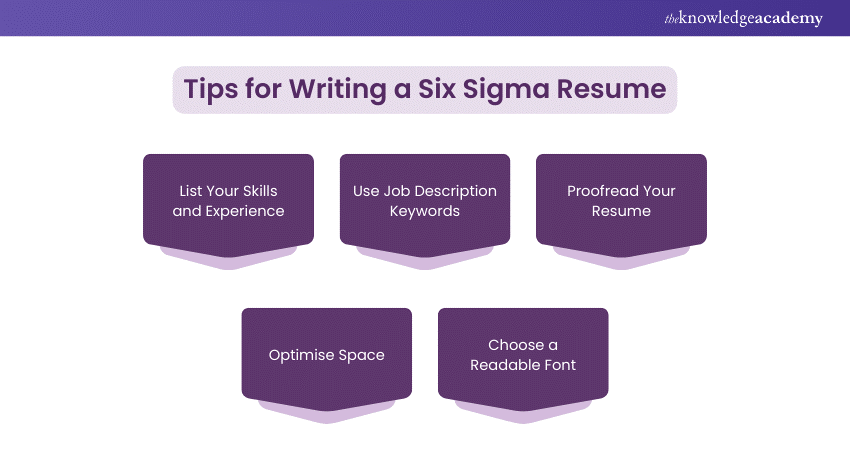We may not have the course you’re looking for. If you enquire or give us a call on 01344 203999 and speak to our training experts, we may still be able to help with your training requirements.
Training Outcomes Within Your Budget!
We ensure quality, budget-alignment, and timely delivery by our expert instructors.

Six Sigma is a powerful methodology to improve business processes. It reduces variability and eliminates defects. Adding Six Sigma to your CV can significantly enhance your job prospects. It shows your dedication to quality and efficiency. This step-by-step blog will show you How to Add Six Sigma to Resume and effectively showcase your Six Sigma skills on your resume.
Table of Contents
1) How can you Showcase Your Six Sigma Skills on Your Resume?
a) Quantify Your Results and Impact
b) Align Your Resume With the Job Description
c) Highlight Your Projects and Achievements
d) Include Certifications
2) Benefits of Adding Six Sigma to Your Resume
a) Enhance Visibility
b) Boost Salary Potential
3) Tips for Writing a Six Sigma Resume
a) List Your Skills and Experience
b) Use Job Description Keywords
c) Proofread Your Resume
d) Optimise Space
4) Conclusion
How can you Showcase Your Six Sigma Skills on Your Resume?
Wondering how to jot down the skills you’ve acquired on your resume and make it look attractive. Do not worry because we have got your back. Go through the below steps to learn How to Add Six Sigma skills to your Resume.
Quantify Your Results and Impact
Quantifying your results is crucial when adding Six Sigma to your resume. Employers want to see the tangible benefits you've brought to previous organisations. Use specific metrics to highlight your achievements.
For example, instead of saying "improved process", state that you "reduced production time by 25%." Or "decreased defect rates by 15%" thanks to your Six Sigma initiatives
a) Example 1: "Implemented Six Sigma strategies that reduced operational costs by 20% over six months."
b) Example 2: "Led Six Sigma project that increased customer satisfaction scores by 30%."
Align Your Resume with the Job Description
Customising your resume to match the job description is essential. Identify the vital skills and experiences the employer is looking for. Ensure your resume highlights these areas. If the job requires experience in reducing process variability emphasise your Six Sigma projects that achieved this.
Highlight Your Projects and Achievements
Detail the Six Sigma projects you've been involved in, emphasising your role and outcomes. Describe the problem, the steps you took using Six Sigma tools, and the results.
a) Example 1: "Managed DMAIC project that addressed production delays. This resulted in a 40% increase in on-time delivery."
b) Example 2: "Led a cross-functional team to implement Six Sigma methodologies. The project reduced cycle time by 35%."
Include Certifications
Certifications are critical to validating Six Sigma expertise. Clearly list your Six Sigma certifications. Include the issuing organisation and the date of certification.
a) Example: Obtained Lean Six Sigma Certification Training from The Knowledge Academy.
Display Your Experience
Showcase your Six Sigma experience, detailing your professional history. Focus on roles where you applied Six Sigma principles. Also, highlight significant improvements achieved.
Example 1: "Process Improvement Manager at XYZ Corp January 2018 - Present. Spearheaded multiple Six Sigma projects. This led to annual savings of GBP 394,450."
Example 2: "Quality Assurance Specialist at ABC Ltd, June 2015 - December 2017. Implemented Six Sigma methodologies to enhance product quality. Reduced defects by 20%."
Benefits of Adding Six Sigma to Your Resume
Now that we learned how to represent our skills onto the resume in the most attractive manner. You must want to know why they are beneficial for you or your resume and why we should add them.
Enhance Visibility
Adding Six Sigma to your resume makes you stand out in the competitive job market. It signals to employers that you possess specialised skills in process improvement. It also indicates quality management expertise.
a) Benefit: Improved chances of getting shortlisted for interviews.
b) Benefit: Enhanced perception of your problem-solving abilities. It shows your dedication to quality.
Boost Salary Potential
Six Sigma certification can significantly boost your earning potential. Professionals with Six Sigma skills are often viewed as valuable assets. These skills can lead to substantial cost savings and efficiency improvements for their employers.
a) Benefit: Higher salary offers compared to non-certified peers.
b) Benefit: Increased opportunities for career advancement and leadership roles.
Ready to elevate your problem-solving skills and optimise process efficiency? Sign up for our Six Sigma Yellow Belt Course.
Tips for Writing a Six Sigma Resume
Writing a resume that highlights your Six Sigma skills involves a strategic approach. You need to present your qualifications in such a way that it catches the eye of hiring managers. Make sure it aligns with job requirements. Here are some tips to help you create a compelling Six Sigma resume:

List Your Skills and Experience
1) Identify Relevant Skills:
a) Begin by listing all the Six Sigma skills you possess. These may include DMAIC (Define, Measure, Analyse, Improve, Control), Project Management, Statistical Analysis, and problem-solving.
b) Mention both hard skills (e.g., proficiency in Minitab or other statistical software) and soft skills (e.g., leadership, communication).
Learn how to contribute to a project team using DMAIC Methodology. Sign up now!
2) Highlight Your Experience:
a) Detail your professional experience with Six Sigma methodologies. Include specific projects where you applied Six Sigma principles.
b) Quantify your achievements. For instance, mention how you reduced process cycle time by 20% or saved the company £50,000 annually through process improvements.
c) Use action verbs such as "implemented," "led," "optimised," and "analysed" to describe your contributions.
Use Job Description Keywords
1) Study the Job Description:
a) Carefully read the job posting to identify keywords and phrases that the employer is looking for. These often include specific skills, certifications, and experience related to Six Sigma.
b) Common keywords might be "Lean Six Sigma," "process improvement," "quality management," and "efficiency enhancement."
2) Incorporate Keywords Naturally:
a) Integrate these keywords into your resume naturally. Avoid keyword stuffing, this can make your resume look forced and inauthentic.
b) Ensure that your resume remains readable and flows well while still including the essential terms.
Proofread Your Resume
1) Check for Errors:
a) Read your resume multiple times to catch any spelling or grammar errors. These can disassociate from your professionalism and attention to detail.
b) Consider using tools like Grammarly or Hemingway to help identify and correct mistakes.
2. Seek a Second Opinion:
a) Ask a friend or professional mentor to check your resume. They might spot errors you missed or suggest improvements to enhance clarity and impact.
Optimise Space
1) Be Concise:
a) Aim to keep your resume within one to two pages. Employers often skim through resumes quickly, so conciseness is key.
b) Focus on the most relevant and attractive aspects of your experience and skills.
2. Use Bullet Points:
a) Bullet points help break down information into easily digestible pieces. This makes it easier for hiring managers to immediately scan your resume.
b) Each bullet point should be a precise, impactful statement highlighting your accomplishments and responsibilities.
Choose a Readable Font
1) Select the Right Font:
a) Use a professional, easy-to-read font such as Arial, Calibri, or Times New Roman. Font size must be kept between 10 and 12 points.
b) Avoid overly decorative or complex fonts that can make your resume difficult to read.
2. Ensure Consistency:
a) Maintain consistency in font type and size all throughout your resume. This includes headings, subheadings, and body text.
b) Consistent formatting helps create a polished, professional appearance.
Ready to become a true Six Sigma expert and lead organisational change? Master the art of process improvement with our Six Sigma Master Black Belt Course.
Conclusion
We hope you enjoyed reading our blog and understood How to Add Six Sigma to Resume. Incorporating Six Sigma into your resume is a powerful way to showcase your expertise in process improvement and quality management. Enhance your job prospects, boost your salary potential, and advance your career by effectively presenting your Six Sigma skills. Good luck with your job search!
Frequently Asked Questions

Six Sigma rules focus on reducing variability and defects in processes through a structured methodology, primarily using the DMAIC (Define, Measure, Analyse, Improve, Control) framework.

It is called Six Sigma because the term "Sigma" represents standard deviation in statistics. Achieving Six Sigma quality means a task that does not produce more than 3.4 defects per million chances, representing near-perfect quality.

The Knowledge Academy takes global learning to new heights, offering over 30,000 online courses across 490+ locations in 220 countries. This expansive reach ensures accessibility and convenience for learners worldwide.
Alongside our diverse Online Course Catalogue, encompassing 17 major categories, we go the extra mile by providing a plethora of free educational Online Resources like News updates, Blogs, videos, webinars, and interview questions. Tailoring learning experiences further, professionals can maximise value with customisable Course Bundles of TKA.

The Knowledge Academy’s Knowledge Pass, a prepaid voucher, adds another layer of flexibility, allowing course bookings over a 12-month period. Join us on a journey where education knows no bounds.

The Knowledge Academy offers various Six Sigma Certification Training, including Lean Six Sigma Green Belt, Lean Six Sigma Yellow Belt and Lean Six Sigma Black Belt. These courses cater to different skill levels, providing comprehensive insights into Lean Six Sigma Roles and Responsibilities.
Our Business Improvement Blogs cover a range of topics related to Lean Six Sigma Certification, offering valuable resources, best practices, and industry insights. Whether you are a beginner or looking to advance your Business Improvement skills, The Knowledge Academy's diverse courses and informative blogs have got you covered.







 Top Rated Course
Top Rated Course




 If you wish to make any changes to your course, please
If you wish to make any changes to your course, please


